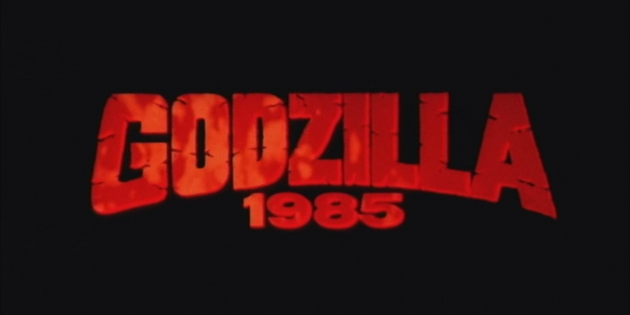So as I sit down to write this review, a lot of fond memories are coming back to me about this film. I first saw it in the early 90’s as after exhausting the dinosaur films at the local video rental store my father made the mistake of renting me my first Godzilla film. I cannot say how old I was, but 6 or 7 would be a good guess. If I hadn’t absolutely loved the film, this site would not be here now and my life would probably been a lot more boring.
I remember taking the VHS tape out of its clear plastic cover that the video rental store had provided, and popping it in. The late summer sun going down, and the smell of someone barbecuing in the neighbourhood wafting in through the cracked windows of the upper level of my parents’ house. It is actually kind of funny, because the VCR in the house was kept under the TV in their room.
So there I sat, on my parents’ bed waiting for another dinosaur movie to come on. My father had hyped it up a little bit, saying this was the biggest dinosaur of them all, so I was hanging out there waiting for him to show up.
…..and them the opening credits started….
Now for those of you who have not seen the film yet, here is where the spoilers start. You’ve been as warned as much as you are going to get.
I do not remember that much of that first time, it has kinda bled together with all of the others since then, but the credits of this film are very much unlike anything that has come since. And I will challenge any Godzilla fan to discredit their uniqueness.
The opening credits are set across a black screen, not unlike a lot of other films out there, but what made this cool then, and nostalgic now, is the burning away of the letters. Now as you watch, you will not know that it is actually the title that is being burned away, but as it burns, you see lava from an eruption in the background. It was a great effect, and more than any old science book, cemented my young mind’s connection between dinosaurs and volcanoes.
Since the movie is a direct sequel to the 1954 original Godzilla: King of the Monsters or Gojira (however you want to think of it) the 1985 is used to differentiate it from its famous predecessor. The year flashes in (very 80’s if you ask me) and immediately you are taken to a boat that is obviously having a hard time with the local weather.
We watch as the boat is is pummelled by wind and rain, its hard crew of fisherman not at all surprised by it, but working their hardest to keep the ship going….that is except for the greenhorn wearing the bright orange life jacket in the background. The helmsman of the vessel asks him if he is alright, and he sheepishly confirms he is…little does he know what he is in for…
All at once there is a flash in the distance, and an island that is nearby starts having an eruption (as if the storm wasn’t fun enough). As the crew are shocked to watch the events unfold beside them – because how often do you see a volcano erupt right?
Suddenly, there is a flash that is more like lightning, then another, and another and a huge shadow rises up, moving, unaffected by the storm raging around it – and then a deafening roar finished by a deep guttural growl…
He’s back.
Now I do not want to give away any more plot, but this film is one of only four (3 to purists) Godzilla films to day where it is Godzilla vs Humanity and there are no other contenders. These films being the original, Gojira aka Godzilla: King of the Monsters, This film, Godzilla 1985, Godzilla (1998 aka GINO), and Shin Godzilla. You could make a case for the recent anime Godzilla, but the killer green critters and other monsters that appear in the opening credits keep it out of this group for me.
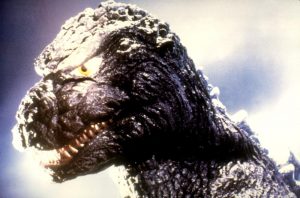
I enjoy (most of) these films immensely, because they show a contemporary societal reaction to Godzilla. Also, in my humble opinion, a near invincible, gigantic, atomic fire spewing creature poses enough of a threat to have his own solo film from time to time. In this iteration of the formula that came out in the 80’s, the Cold War between Russia and the United States is a cornerstone of the plot, as is the misuse of nuclear energy. In the 1985 version, which I watched in Kansas in the USA, the American English dub goes so far as to change the subtitles of what the Russian characters are saying. The fact that the audio hasn’t been changed for them is pretty funny as well (if you speak Russian). The technology is also an interesting element in the Godzilla vs Humanity films as well. In the 1954 film the protagonists defeat Godzilla with the use of a new chemical agent, the military having failed with conventional means. In this film, the military fails, as the point is made abundantly clear that Godzilla is a walking force of nature that is not capable of being killed (some great lines in the movie about that by the way), and in the end the protagonists must defeat Godzilla using his nature, and some help from mother nature as well. It is a great brains over brawn story line. Shin Godzilla is quite similar in theme, and the odd one out, the American Godzilla 1998 has the military killing “Godzilla”, a departure that has many a fan irritated with today.
How the protagonists of the film manage to neutralise Godzilla, if that is the word to use, is actually pretty ahead of its time considering this is a film made in the 80’s. The premise of acknowledging that they cannot defeat Godzilla by using violent measures and instead choosing to use his natural behaviour against him is unique in the Godzilla series. It is interesting that this successful approach was never used again in the cannon of films that came after. That said, if I could have made a Mecha King Ghidorah, I would have gone for that as well.
Godzilla’s image is also a departure in this film, as he is much more menacing than the fairly friendly 1975 Godzilla, which was his previous movie outing. However, despite being more menacing, this Godzilla has much in common with the 1954 original. The small, distinctly non-saurian ears are back, he has a large pair of fangs, he has multiple large rows of dorsal plates, and he has four toes. Many of these characteristics had not been present since Godzilla’s second movie outing in 1955. His roar was also changed for this film, and oh is it fantastic. Personally, it is the iconic Godzilla roar for me, and it set the standard for the rest of the Heisei series that came after it. The combination of all of these factors make this film’s Godzilla suit one of my favourites, regardless of nostalgia.
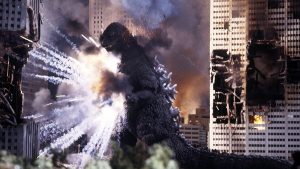
So I have gushed about Godzilla, but I have to say that this film boasts many fantastic human characters as well. Ken Tanaka does a fantastic Goro Maki, a reporter thrust into a scoop that may be too big for him to handle, Shin Takuma is our down to Earth fisherman, and first main character, and then there is his sister played by Yasuko Sawaguchi as Naoko Okumura. The great thing about Naoko is that she is smart, gets in the thick of it and is a normal person – rather than the one central female role being reduced to a typical scream queen. However, all of these characters are quickly overshadowed once my favourite two characters come on the screen – Yosuke Natsuki as Professor Hayashida and the iconic Raymond Burr reprising his role from Godzilla: King of the Monsters, as Steve Martin. These two characters are stand outs because unlike the rest of the cast, they were there the first time Godzilla came ashore. Steve Martin was the sole American survivor, and Hayashida barely got out alive, being orphaned in the process. These characters know what the military is up against, they know what it looks like to see weapons do absolutely nothing to our massive scaled antagonist. It is there solemn testimonies, portrayed so well, that gives the film a true sense of dread preceding the main night attack. They just steal the show, you have to watch to understand.
Ok, so there is a lot of good in this film, but what about the 13% rating on Rotton Tomatoes? And the poor critical response in the USA? What happened? To be fair, this film was dramatically changed from its Japanese original, so there are some moments that do not fit the tone of what the Japanese writer and director intended. To give an example…Dr. Pepper. That beverage makes about as many cameos in this film as the Japanese Prime Minister.
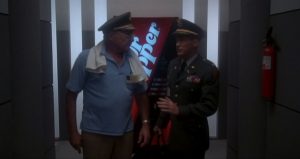
Another thing that was panned by critics was the dub. A dub is a dub is a dub. It will never be as good as the original dialogue, but if you don’t want to learn the original language, and you will not bother with subtitles…well, you are kinda stuck with a dub. Of course, I will mention again that the original dialogue was changed in the dub over of the Japanese cast so a lot of the subtle dialogue intricacies were lost in their translation to English. These intricacies are lost because the team that dubs the dialogue has to try to try and match words to lip movement, otherwise it is too detracting. However, this makes some of the dialogue a bit cheesy, when the original scene may have been intended to be quite serious.
The last things that was torn apart by US critics were the special effects. As a kaiju fan, I will be quick to jump to the defence of Tokusatsu and the traditional use of an actor in a suit to portray a monster. The amount of wo
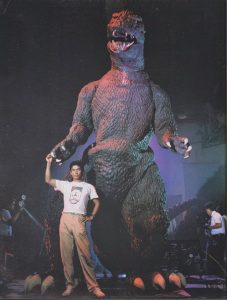
rk, art and timing that go into the monster shots are a lot harder than a lot of audiences give them credit for. Godzilla 1985 also employed the use of a large mechanical Godzilla, dubbed “Cybot Godzilla” for many of the close up scenes of his head and torso, so you have to give the special effects artists some credit for that creation at the very least.
In the end, Godzilla may not be the same film as the Japanese “Return of Godzilla”, but it certainly has its moments, especially if you grew up with Godzilla: King of the Monsters instead of Gojira. It also is an interesting film to watch for historical purposes to see the scenes that were altered for American audiences and understand the reasons why.
As a reviewer, I am never going to give a movie stars, or rate it out of ten etc, films shouldn’t be reduced to scores, they are works of art, a cumulative effort of all of the cast and crew that made the films. One doesn’t go into an art museum and rate the works of art, you can simply like some more than others, and perhaps get some more than others, but you respect that it is art. So, to follow in that spirit, as a fan of this film, I will give it a hearty recommend. It may not be the best or smartest Godzilla movie ever made, but it is a rather unique take which makes it an interesting watch. I would also recommend watching Godzilla 1985, and the Japanese version, Return of Godzilla to get a feel for the different flavours that the films have to offer.
At this time, Godzilla 1985 is a hard film to come by. It has not been released on DVD or Blu-Ray and can only be found on VHS (or some nefarious piratey method which we do not support or condone). However, if you wish to see the original Japanese version, I have provided the region one American version which was only recently released, and is good value. You will need a region-less DVD or Blu-Ray player to enjoy the film in this format, but if you are a die hard kaiju fan, this is a worthwhile investment as USA and Japanese releases are both region 1.
Thanks for reading, and I hope you really enjoyed the review. Hopefully, if you haven’t seen the film before this will get you interested and you may give it a watch – who knows, you may open yourself up to a whole new genre of films! Thanks again, and keep it kaiju!

